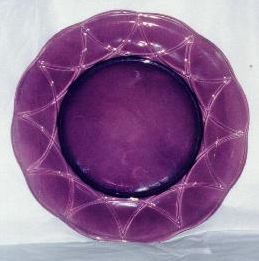
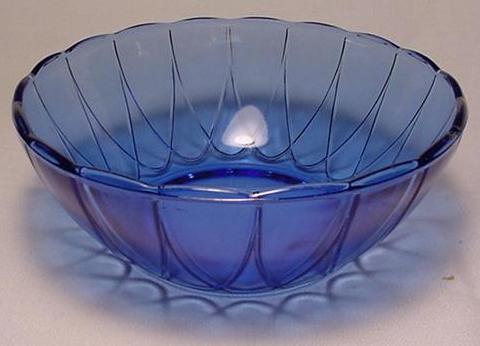
Newport
Written by Rosemary Trietsch
Okay folks, get out your Shirley Temple bowl, pour yourself a big bowl of Cheerios, and settle down for the last installment of “Whatever Happened to all that Blue Glass Hazel Atlas had Leftover after General Mills Cancelled the Shirley Temple Promotion?” (By the way, the General Mills executives who ended this promotion are rumored to be the same folks who cancelled ‘Star Trek’ 30 years later….) We’ve already learned that Shirley’s demise gave birth to cobalt Royal Lace and Moderntone. Now we’ll take a closer look at their little brother, Newport.
There is very little documentation on the Newport pattern. Weatherman didn’t list it as a separate pattern in Book One, nor did she include it in the section of occasional pieces. Sandra McPhee Stout is the first to document Newport, (Depression Glass in Color, 1970). Although she attributes it to Hazel Atlas, she calls it by the collector’s nickname “Hairpin”. In the price guide for book one she lists Hairpin with the notation: “If anyone knows more about this pattern, please write.” It’s not until 1972 in Weatherman’s Price Trends IV that Newport is called by its correct name, and a complete list of pieces and the colors available is included. (Well, almost complete, but we’ll get to that.) Since 1974, there’s been no new research uncovered. (I say that as a challenge to you folks – go out and start looking!)


What we do know is that Hazel Atlas introduced Newport in 1936. Its production was much more limited when compared to Hazel Atlas’ other cobalt blue patterns, having only 16 different pieces. Think about it: Royal Lace has 5 different pitchers, 3 different console sets and a cookie jar with at least 6 different disguises. That’s almost as many items as found in the entire Newport pattern. The Moderntone line was expanded in at least two ways: metal lids were added to make ‘new’ pieces from existing shapes, and it was also decorated with ships (not to mention Shirley), so it could be sold as part of the Sportsman Series. Newport just didn’t spark the same creative energy at Hazel Atlas that its big brothers did. Even its use as a promotional premium suggests a lesser pedigree in Hazel Atlas’ mind: whereas you had to save ‘Money Value Certificates’ from flour to get Moderntone, Newport was given away if you purchased $4.00 in seeds (Florence 13th edition, pp. 132,140). It’s pretty clear that the perceived value of Moderntone was higher than that of its little brother.
Still, people must have loved Newport then as much as they do now as enough has survived the years to make owning a set today possible. Of course, it will cost a bit more than it did in 1936, but most folks are happy to pay the price when they’re lucky enough to find some for sale. Newport was originally sold in boxed sets that included cups, saucers, 2 sizes of plates, 5 ½ inch cereal bowls, the 11 ¾ inch oval platter, and the 8 /14 inch round bowl. The sugar & creamer and salt & pepper shakers were sold in two different 7 piece breakfast sets. In addition to these 4 pieces, you had the choice of a chrome toast holder, tray and sugar bowl lid, or a chrome tray and the Moderntone butter dish (glass base with chrome lid) to complete the 7 pieces. (These sets cost $.95 each or $11 per dozen back in the 1930’s. Ah, if only….) Sherbets, cream soup bowls, 4 ¾ inch berry bowls, the 11 ¾ inch sandwich plate and 9 oz tumblers complete the list of 15 items found in the original catalog listing. But collectors today hunt feverishly for a 16th item: dinner plates.
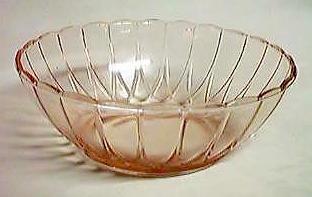
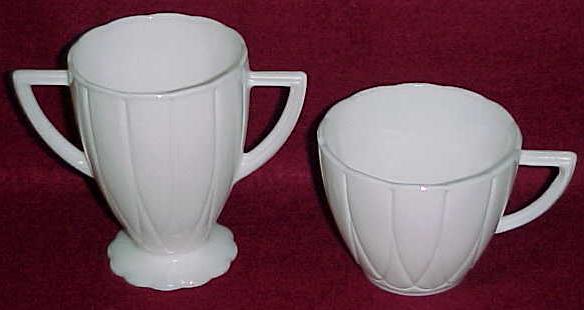
There are 3 plates listed in the company records: 6-inch, 8-½ inch, and 11-½ inch. We know that catalog listings and actual sizes often varied, and as molds wore out and were replaced, dishes grew or shrunk as much as an inch. The 8 ½ inch plate really does measure 8 ½ inches, but the 6-inch plate actually measures 5 7/8 inch and the 11-½ inch sandwich plate is closer to 11 ¾ inch in actual size. Both of these variations are well within normal range. However, there is another plate that measures 8 13/16ths inches that’s different from the luncheon. These plates have a larger center area and narrower hairpin rim than the regular luncheon plates, and are now considered dinner plates. They may have resulted from molds that were reworked; though I think they’re an earlier piece that was dropped from production or gradually phased out due to the similarity to the 8 ½ inch plate. Why?
Like Moderntone, Newport was originally produced from 1936 to 1940 in blue, amethyst (called Burgundy by Hazel Atlas) and some light pink. Also like Moderntone, Newport was made in platonite white and fired on colors through the 1940’s and into the early 1950’s with 2 exceptions: the 5 ¼ inch cereal bowl and the 8 13/16th inch ‘dinner plate’ haven’t turned up in platonite. Since these pieces aren’t part of the later production, it’s reasonable to assume that they were part of the early production years. Their relative scarcity when compared to the 4 ¾ inch bowl and 8 ½ inch plate adds to the case supporting an early mold change and thus a shorter production period. Remember, in the 1930’s Hazel Atlas was struggling against a depressed economy and cancelled contracts. Cutting two ‘extra’ pieces from Newport freed more blue glass for Royal Lace and Moderntone, which were bigger moneymakers. (Now will someone please find some old company records somewhere that support this theory?)
Cobalt blue Newport is slightly more expensive than amethyst, due mostly to the fact that cobalt glass collectors are fighting with Newport collectors for pieces. In my experience, amethyst has been harder to find. There are no ‘impossibly rare’ pieces, but tumblers, sandwich plates, 5 ¼ inch cereal bowls and the 8 ¼ berry bowl will give you a run for your money. Condition is the biggest obstacle in collecting as the plain center area on the plates makes knife cuts and scratches stand out. (The same is true for Moderntone.) If you like the pattern but not the wear marks, try the platonite colors or mix and match to suit your taste. I know of two different collectors who have mixed sets of platonite white and cobalt blue - it really looks nice and you don’t have to worry about spaghetti sauce clashing with the blue plates.
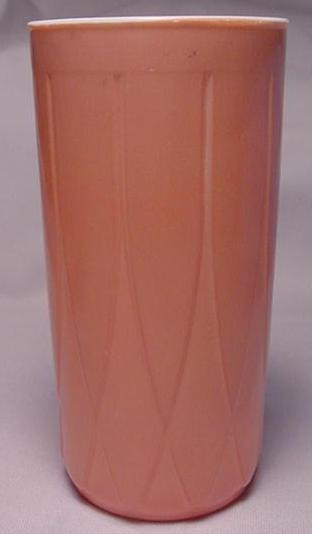
One last note: a collector wrote to me after reading my Moderntone article and asked about something I have noticed but never paid attention to before. She said that condition is very important to her and she passes on plates with use marks, but she had noticed that some plates with no signs of wear had a sort of foggy area in the center about the size of a silver dollar. She wondered if this was ‘usual’ or if the plates had been damaged somehow. I’ve seen the same thing on both Newport and Moderntone –an area in the center of the plate that looks a little cloudy or sometimes has a fuzzy, sort of orange peel texture. I’m pretty sure that this is caused by the way the plates were molded as it’s too consistent from plate to plate to have been caused by misuse. This center area may have been a little higher than the rest of the mold, and so air would collect there as the glass was pressed. Another possibility is that the plunger/suction cup device that lifted the hot plate out of the mold may have left this mark.
However it happened, this fuzzy mark is a manufacturing mark: not after market damage. Remember that, for the most part, Depression glass was inexpensive glass made as cheaply as possible. Bubbles and mold marks are part of its charm. Unless half the handle is missing or there’s a hole in the cup, don’t let a bubble or straw mark prevent you from buying something. You’ll probably find the same flaw in the same place on every piece. I remember the first Cambridge draped lady flower frog I found: I almost didn’t pay the $5 the person wanted because it had a big straw mark around the base and I figured it had to be a fake as Cambridge would NEVER allow such a manufacturing flaw. I’m glad I didn’t listen to myself that day as that same mark is on every one I’ve seen since – including those pictured in the Cambridge books. Manufacturing imperfections are part of the charm of Depression glass. Think of them as ‘beauty marks’ – like Cindy Crawford’s mole…. Happy Collecting!
Sources: Weatherman; Colored Glassware of the Depression Era, 1970 Price Trends IV, Spring 1972
Colored Glassware of the Depression Era Book 2, 1974
Price Trends for Book 2, 1977
Sandra McPhee Stout; Depression Glass in Color, 1970
Gene Florence; Collectible Glassware of the 40’s 50’s and 60’s, 1998
Collector’s Encyclopedia of Depression Glass, 1998